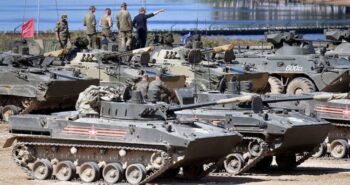By Ross Harrison
 Power dynamics between the major global and regional powers have indirectly influenced the civil wars currently plaguing the Middle East.
Power dynamics between the major global and regional powers have indirectly influenced the civil wars currently plaguing the Middle East.
PART THREE
GLOBAL GEOPOLITICS AND CIVIL WARS IN THE POST-COLD WAR ERA
“… an intrastate war may be interrupted by an external power or become internationalized.”
Any power equilibrium that existed between Soviet and American allies in the Middle East fell away with the end of the Cold War and the collapse of the Soviet Union.
The asymmetry became apparent very quickly, with U.S. allies Israel, Saudi Arabia, Egypt, and Turkey emerging from the Cold War period relatively unscathed, while former Soviet allies Syria, Iraq, Yemen (South), and Libya were handed tougher cards to play.
While the end of the Cold War wasn’t a direct causal factor in these four countries succumbing to the Arab Spring and sliding into civil war two decades later, the loss of the Soviet patron put pressure on each of them that affected their capacity to cope with the social, economic, and political pressures that later came their way.
THE EFFECT ON THE DOMESTIC POLITICS OF FORMER SOVIET ALLIES
All countries in the region, including American allies, took a “strategic haircut” when the superpower competition came to an end. U.S. alliances in the Middle East had been largely forged as instruments of containing the Soviet Union.
Though containment imperative disappeared at the end of the Cold War, support for Israel, preserving access to oil, and the sunken costs associated with U.S. alliances in the Arab world, kept the United States tethered to its allies in the region.
But former Soviet allies in the region were disproportionally affected and left holding the bag. The effect of the end of the Cold War on the political-economy of these countries was almost immediate.
With the loss of their benefactor in the form of the Soviet Union, weak states became weaker, as they saw their legitimizing principles dissipates.
When the Soviet Union collapsed, it was clear that to avoid a legitimacy crisis the Syrian regime had to develop new internal sources of financial investment as a substitute for the loss of Soviet-era transfers.
This required a revision of the old social contract that had been maintained for decades by a sprawling public sector kept afloat with the help of the Soviet Union, and a private sector that had been gutted by the state in the 1960s with the concomitant rise of crony capitalism.
But there were difficult obstacles to contract, as the Syrian political-economy private sector. There were valiant attempts, such as tourism and telecoms. But there were problems, such as economic drags associated with attempts to retire Soviet-era debt, an effort that began before the end of the Cold War.
Another problem was that the compact by which the state provided subsidies for food to the lower and middle classes made escape from the old public-sector model impossible, at least not without risking serious instability.
The regime was unable to widen its base of support by orienting the economy toward the private sector while still clinging to its traditional constituencies countries was almost immediate.
Moreover, the reality of a crony capitalist class beholden to the state and the Assad family itself made a transition to a private sector system difficult. Instead, the administration of President Bashar al-Assad tried to forge a middle path, adopting a “social market” approach to economic and political governance.
But the sprawling public sector that had been created over the previous decades made successful adjustment to the new approach difficult. Instead of privatizing public-sector holdings to stimulate growth, the government merely tried to reform them, mostly unsuccessfully.
There was also the reality of regime distrust of an independent private sector, perhaps a hangover from the years of Soviet influence. In sum, the rigid, praetorian nature of the Syrian state militated against successful adjustment to the shock of the Soviet collapse, particularly given its inability to access significant sources of foreign direct investment.
A full transition from the old Ba’athist political-economy towards a hybrid social market approach risked unleashing competition between neo-liberalism and Islamism for the economy of Syria, something that could (and did) eventually lead to unrest.
The inability of strike a balance and the lingering effects of decisions made during the Soviet era made it difficult for the regime to respond to the drought that affected Syria from 2006-10, factor that contributed to the slide into civil war in 2011.
The sclerotic state structure that was a legacy of the Cold War era proved incapable of responding effectively to the water shortage. And the climate refugees who had migrated to the major cities acted as kindling for the firestorm of the Arab Spring protests that beset Syria.
Shifting our gaze to the macro level, it seems clear that in the post-Cold War era, Syria was forced to choose between economic reform and regional security.
To cope with regional isolation at the end of the Cold War, Syria felt compelled to strengthen its already strong ties with Iran. But it couldn’t square the circle of being allied with Iran and seeking capital investments from Western sources. While there was investment from the Gulf Arab states in a few projects, it wasn’t enough to compensate for the shortfalls of the Syrian government’s economic policies.
One way to think about this is that the loss of its superpower patron put the Syrian regime in the unenviable position of having to forego its economic interests in favor of its security concerns.
It would be foolhardy to suggest that the Syrian civil war which started in 2011 was the result of these earlier post-Cold War adjustments. Syria’s descent into conflict was a result of the contagion effect of the Arab Spring moment, the brutality of the regime, and the impact of drought. But it is also important not to discount the failure of the regime to adapt to changed economic circumstances as at least contributing to fraying of the country’s social contract.
While neither the broader Arab Spring nor the Syrian civil war were solely a result of economic privation, they were both sparked by resistance to sclerotic regimes that limited the political and economic potential of newly energized populations.
It wouldn’t be reckless to say that the decisions the Assad regime confronted at the end of the Cold War limited the options it had to make needed adjustments and should be considered stress factors that affected the regime’s capacity.
AMERICA’S UNIPOLARITY IN THE MIDDLE EAST
The U.S. started to flex its muscles even before the formal collapse of the Soviet Union. In the last gasps of the Cold War, Moscow barely objected when the United States crossed the Kuwaiti border into Iraq in 1991 to chase down Saddam Hussein’s much vaunted Republican Guard Corps, and pummeled Baghdad from the air in a bid to liberate Kuwait.
While this didn’t directly lead to the 2003 invasion of Iraq by the United States, it set the stage for the later invasion, which did ultimately lead to civil war.
It is useful to look at the overall strategic patterns of a U.S. running unopposed in the Middle East during this period. There were two phases to this unipolar moment. The first is “soft unipolarity,” when the United States imposed a sort of Pax Americana on the region.
This took the form of the Clinton administration’s strategy of dual containment of both Iran and Iraq in the 1990s, which emerged in response to the Iranian revolution of 1979 and the need to contain an aggressive Saddam Hussein after his attempt to annex Kuwait in 1990.
This approach of indirectly trying to shape the power dynamics of the Middle East gave way to more direct and “hard unipolarity” in the wake of 9/11, when the United States saw an opportunity to aggressively reorder the region in its own image.
The invasion of Afghanistan in 2001, the invasion and occupation of Iraq in 2003, and the ultimatum issued to Damascus to withdraw Syrian forces from Lebanon in 2005, were all part of this new “sharp-elbowed” approach.
These manifestations of unipolarity had a profound effect on the foreign policy calculations of former Soviet allies. Just as the end of the Cold War had a shock effect on their domestic politics, the reality of American unipolarity during this period played into their foreign policy calculus. As fleeting of a moment as it might have been, U.S. dominance posed foreign policy challenges for Syria, Iraq, Libya, Yemen, and Afghanistan.
A RESISTANCE FRONT FORMS
In the realist tradition of international relations theory, imbalances of power within a system will lead to an adjustive response. Once the Soviet Union collapsed, its former Middle Eastern allies had to contend with the resultant regional imbalance largely on their own.
Syria had already started hedging its bet on the Soviet Union before the formal end of the Cold War. To compensate for the poor hand Syria believed it was being dealt with an obviously weakening Soviet Union, Damascus forged closer ties with Washington, evidenced by its inclusion in the U.S.-led coalition that went to war against Iraq in 1990, participation in the Madrid peace conference in 1991, and subsequent negotiations with Israel.
But after 9/11 and the U.S. invasion of Iraq in 2003, Damascus feared it might be next. The Syrians tried to weaken the United States position to avoid an attack by allowing Sunni Iraqi insurgents to cross over from Syria into Iraq to slow down the Americans.
This and Syria’s later forced expulsion from Lebanon by the United States after the assassination of Rafik Hariri in 2005 pushed Damascus into a defensive crouch. The loss of its Soviet patron, and the “hard” edge of American unipolarity, gave Syria the incentive to move closer to Iran as part of an axis of resistance.
It is important to note that the close relationship between Iran and Syria predated the end of the Cold War. It was in fact cemented shortly after the Iranian Revolution of 1979 and was forged into a strategic partnership after Iraq invaded Iran in 1980, when Syria broke ranks with bid to weaken Iraq’s Saddam Hussein.
For Iran, Syria represented a toehold in the Arab world, and a conduit through which to offer material and logistical support for Hezbollah in Lebanon. But that partnership was fortified and took on a whole new meaning at the end of the Cold War, particularly after 9/11.
For Syria it was a need to break out of an isolation that could make it susceptible to an American attack following the 2003 invasion of Iraq, and a desire to boost Syria’s strategic relevance to Israel in a post-Soviet environment.
For Iran the resistance front was initially a defensive shield against efforts by the United States and Saudi Arabia to contain it, particularly after George W. Bush’s “axis-of-evil” speech, and it was motivated by a need to develop a deterrence and retaliatory capability against an Israeli or U.S. attack.
After the United States became mired in Iraq, and after the Arab Spring started, Iran also saw an opportunity to use the alliance to further its broader interests in the region.
…
to continue in part 4
***
Ross Harrison is a non-resident senior fellow at MEI and is on the faculty of the School of Foreign Service at Georgetown University and the faculty of the political science department at the University of Pittsburgh. He has been published in The National Interest, Al Monitor, and The Middle East Journal.
______________





